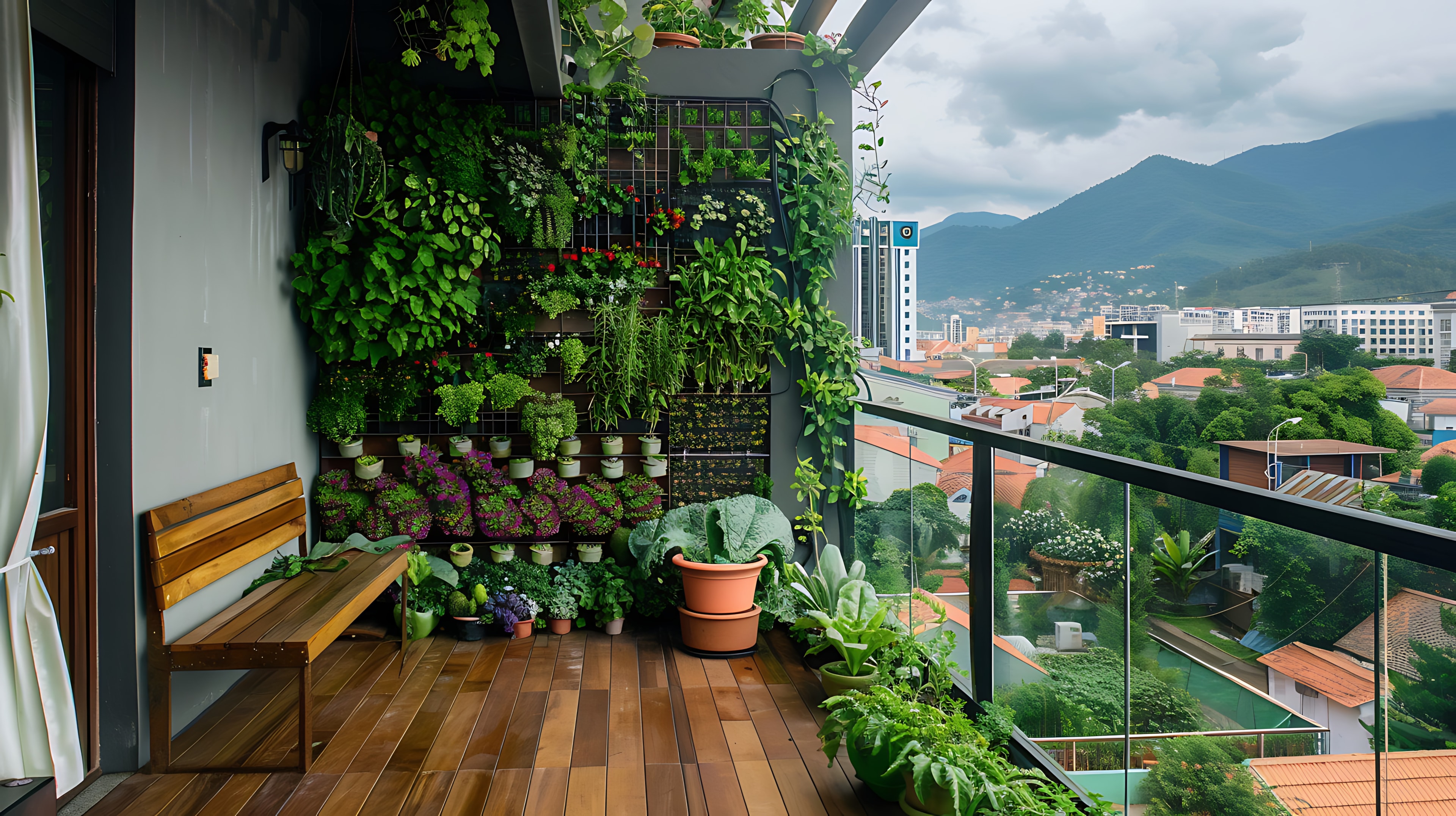
Have you ever looked at your small outdoor space and wished you could do more with it? You’re not alone. Lack of space is a common problem, but there’s a simple solution—a DIY vertical garden! With a bit of creativity, you can transform any wall into a lush, green oasis.
Urban gardening is becoming increasingly popular as more people look for ways to maximize their small outdoor spaces.
In this post, we’ll guide you through how to craft DIY vertical gardens that not only save space but also enhance your home’s beauty. Ready to create your vertical herb garden?
Key Takeaways:
- Maximize small spaces with a DIY vertical garden
- Learn top techniques for crafting your own vertical garden
- Transform your outdoor space into a green oasis
What is Vertical Gardening?
Vertical gardening is a smart way to save space by growing plants on vertical structures instead of letting them spread across the ground.
This method is perfect for small areas where there isn’t much room to grow plants horizontally, making it an ideal form of container gardening.
By using vertical structures like trellises, walls, or hanging planters, you can create a vertical garden wall that’s both beautiful and practical.
This style of gardening can include things like living walls covered in ivies, neatly arranged pots of fresh herbs, or a mix of different plants. The main idea is to use the space above you, making the most of every inch and creating a garden that grows upwards, almost like it’s defying gravity.

Benefits of Vertical Gardens
Vertical gardens are perfect for anyone with limited space, like small backyards or apartment terraces. They make the most of vertical space by letting you grow plants upward instead of spreading them out like in a traditional garden.
One of the cool things about vertical gardens is how they conserve water. When you water the top plants, the water trickles down to the plants below, so nothing goes to waste.
Vertical gardens are also a great example of sustainable gardening, as they make efficient use of water and space.
These gardens are major space savers and can hold a variety of plants, from flowers to vegetables.
Plus, they’re flexible and easy to access, making it simple to replant or move things around. Whether on a balcony or an exterior wall, vertical gardens are a smart, efficient way to bring greenery into any space.

Choosing the Right Location and Plants for Your DIY Vertical Garden
When setting up your DIY vertical garden, start by picking the right location.
Make sure the spot gets direct sunlight for at least 6 hours a day, as most plants need plenty of light to grow. Think about how much wind the area gets and how easy it is to water the plants.
Consider the microclimate of your chosen location, as factors like wind and sunlight can vary significantly even within a small area.
Whether you’re using a vertical structure like trellises or rain gutters, it’s important to choose plants that thrive in containers, such as herbs or small fruits and vegetables.
Keep in mind the specific needs of each plant, like how much sunlight and water they require, to make sure your garden offers the many benefits of a healthy, thriving green space.

DIY Vertical Garden Ideas and Designs
There are many fun and creative ways to design your vertical garden. Here are some great vertical garden ideas to get you started:
Vertical farming techniques can also be applied to your DIY projects, allowing you to grow a variety of plants in a compact space.
- Hanging Baskets: Use these to grow plants without using up any ground space. They are perfect for small areas and can add a lot of greenery.
- Living Wall: Create a stunning living wall by attaching planters to a wall or using a planter box. This can turn any blank wall into a vibrant display of plants.
- Trellis: Install a trellis to add more greenery to your backyard or patio. It’s a simple way to grow climbing plants and flowers.
- Upcycled Materials: Get creative with materials like pallets or old containers. You can turn these into unique trellises and arbors.
- Old Ladder: Repurpose an old ladder to display potted plants. It adds a rustic touch and is a great way to showcase plants like mason jars filled with herbs or flowers.
- Rocks: Add rocks into each container to aid drainage. Bring in the seeds.
These ideas not only make your space look beautiful but also help you make the most of your vertical space.

Building and Maintaining Your Vertical Garden
To build and keep up your vertical garden, choosing the right soil and care is key. Here’s how to get started:
- Hydroponic systems: using hydroponic systems for your vertical garden, as they can provide efficient nutrient delivery and water management.
- Use the Right Soil: Choose potting soil or soil specifically made for container gardens. This type of soil helps with good drainage and provides the right nutrients for your plants.
- Match Soil to Plants: Different plants need different types of soil. Check what works best for the specific plants you’re growing.
- For example, planting herbs might require soil with good drainage to avoid waterlogging.
- Consider Plant Needs: Each plant has its own needs for soil and nutrients. Research the plants you’ve chosen to see if they need a special type of soil or fertilizer.
- Avoid Chemical Fertilizers: Stay away from harsh chemical fertilizers as they can be too strong for plants. Look for organic or natural options that are gentler and better for your garden’s health.
By paying attention to these details, you’ll ensure your plants have the best chance to thrive and make your vertical garden a success.

Vertical Gardening Techniques for Small Spaces
When gardening in a small space, using the right techniques can help your own vertical garden flourish. Here are some tips to make the most of your vertical trellis and keep your plants healthy:
- Aeroponics is a technique to consider, as it allows plants to grow in a mist environment, saving even more space.
- Drip Watering System: Install a drip watering system to make watering easy and efficient. This helps deliver water directly to the plants’ roots, saving time and reducing water waste.
- Use Mulch: Apply mulch or other weed-suppressing methods around your plants. Mulch helps retain moisture, keeps weeds out, and reduces the need for frequent watering.
- Pest and Disease Control: Follow basic methods to control garden pests and diseases. Regularly check your plants for any signs of trouble, like holes or spots on leaves.
- Natural Weed Killers: Use natural, homemade recipes to kill weeds instead of chemical products. Simple solutions like vinegar or salt can be effective and safer for your garden.
By using these techniques, you can ensure your vertical garden remains healthy and productive, even in a small space.
Upcycling and Repurposing Materials for Your Vertical Garden
Turning old items into garden tools is not only creative but also great for the environment. Here are some fun ways to use DIY projects and upcycled materials in your vertical garden:
- Pallets and Containers: Use old paint cans, pallets, or other containers to build trellises and arbors. These materials can be transformed into stylish supports for climbing plants.
- Old Ladder: Repurpose an old ladder to create a rustic setup for potted plants. Lean the ladder against a wall and arrange pots on each rung for a charming display.
- Terra Cotta Pots: Stack or hang terra cotta pots to create a unique vertical garden. This classic material can be arranged in various ways to add a creative touch to your garden.
- Cedar Vertical Garden: Consider using a cedar vertical garden with a built-in drip watering system. Cedar is durable and weather-resistant, and the drip system helps keep your plants hydrated with minimal effort.
These upcycling ideas can help you make the most of what you have while adding a personal touch to your garden.

Advanced Vertical Gardening Ideas
If you’re ready to take your vertical garden to the next level, here are some advanced ideas to consider:
- DIY Vertical Garden with Cedar Wood: Use a Kreg Jig and cedar posts to build a custom vertical garden. Cedar wood is durable and looks great, making it perfect for a stylish and long-lasting garden setup.
- Drip Watering System: Install a drip watering system in your vertical garden using the Kreg Jig and cedar wood. This system will efficiently water your plants and help them thrive without much hassle.
- Planter Boxes and Hanging Baskets: Combine planter boxes and hanging baskets to add visual interest and functionality to your garden. This mix allows you to grow different types of plants, like herbs or flowers, and make the most of your vertical space.
Consider using modular systems for your vertical garden, as they offer flexibility and can be easily expanded or reconfigured.
With these advanced techniques, you can create a vertical garden that’s not only functional but also eye-catching and perfect for growing a variety of plants, including lettuce and other greens.

Common Mistakes to Avoid in Vertical Gardening
Creating a vertical garden can be rewarding, but there are a few common mistakes you should watch out for. Avoid these pitfalls to ensure your garden thrives:
- Wrong Location: Not choosing the right location can limit your garden’s success. Make sure your garden gets enough sunlight and is sheltered from strong winds.
- Incorrect Soil: Using the wrong type of soil can harm your plants. For a successful herb garden or any small plants, use soil that’s right for containers and has good drainage.
- Insufficient Sunlight: Not providing enough sunlight is another common mistake. Most plants need at least 6 hours of direct light each day to grow well.
- Improper Watering: Overwatering or underwatering your plants can lead to problems. Make sure you water your garden according to the needs of each plant.
- Ignoring Pests and Diseases: Failing to monitor your plants for signs of pests or diseases can lead to bigger issues. Regularly check for any signs of trouble and take action early.
Ensuring plant compatibility is crucial, as some plants may not thrive together due to differing needs.

Conclusion
Creating a DIY vertical garden is a wonderful way to make the most of your space and add beauty to your home.
Even if you only have a small area, you can use the right techniques and materials to build a thriving garden.
By choosing the right plants and using creative solutions, like up-cycling old containers, you can make your garden unique and personal.
Whether you’re growing herbs, flowers, or small vegetables, a vertical garden can bring a lot of joy.
It’s a great way to enjoy gardening through different seasons and create a vibrant space. So, get started and embrace the joys of happy gardening!



